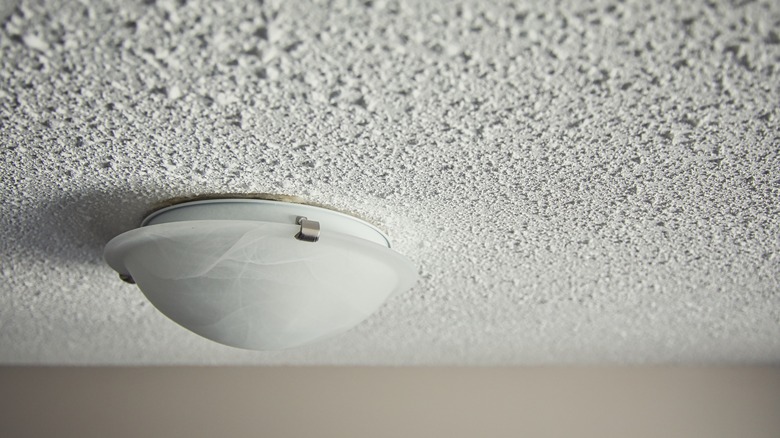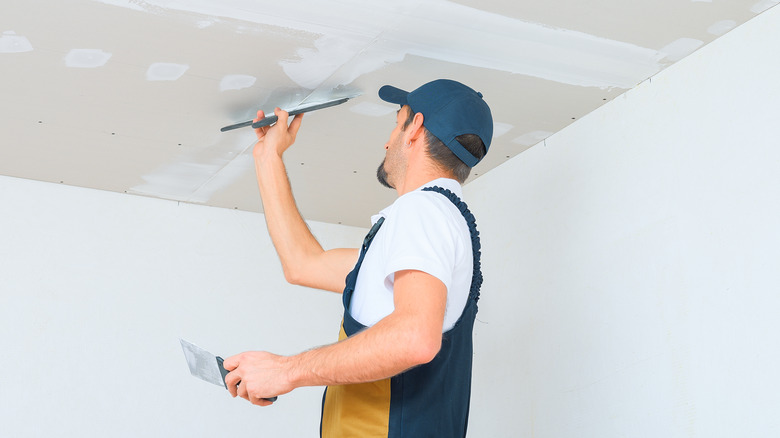Say Goodbye To Popcorn Ceilings With TikTok's Mess-Free DIY
We may receive a commission on purchases made from links.
You may wonder why homes have popcorn ceilings when you're standing in your recently purchased house, marveling at why the previous owners opted for this type of decor. Popcorn ceilings hide imperfections on the surface of the ceiling, however, the texture tends to accumulate dust and cobwebs, making it difficult to clean. In addition to its unsightly appearance, the material becomes brittle over time, leading to tiny particles breaking loose and floating in the air.
Removing a popcorn ceiling can be a messy process. You may need to use an asbestos testing kit before scraping the surface as some popcorn ceilings contain this harmful mineral, depending on the age. You should also wear protective gear to remove a popcorn ceiling such as a mask and eyewear.
To avoid having to clean the mess themselves, some people just choose to hire a professional to remove it, which can cost up to $3,000 due to the asbestos removal. But a cheaper option is to just cover the material. TikToker Coco's Conclusions posted a video that did exactly this, using materials purchased on Amazon to transform the look of a kitchen ceiling. The video claims that the process went quickly and was not difficult to carry out. According to the TikToker, it was certainly cheaper than hiring a pro to remove the popcorn ceiling. It also lasted two years at the time the video was made without showing signs of wear.
How to cover a popcorn ceiling as a DIY project with polystyrene tiles
TikToker, Coco's Conclusions, purchased 19.6x19.6-inch polystyrene ceiling tiles on Amazon for $242 for 96 pieces that cover approximately 260 square feet. Such tiles resist moisture, so they work well in a kitchen where you may have steam from boiling water in the area above the stove. These polystyrene tiles are available in multiple styles, including those that have more decorative elements than appear in the TikTok video.
Each unit weighs only 1 ounce, which makes it easy to handle for a DIY job. The TikTok video and the manufacturer of the product recommend using Styro Pro adhesive to glue them to the ceiling. You'll pay about $40 on Amazon for six tubes of the adhesive, and use a caulk gun with the tube to apply it to the back of the polystyrene tile. Then use a foam paint roller to spread the adhesive across the surface before attaching it to the popcorn ceiling.
Should you need to reduce the size of any particular tile to fit against the wall, the DIY TikToker recommended cutting the polystyrene tile with a pair of scissors, rather than with a box cutter, as this seemed to be more user-friendly. Coco's Conclusions appreciated the ability to paint the tiles after installation, creating the perfect color for the ceiling in their kitchen.
Other options for covering a popcorn ceiling
Perhaps you don't like the look of the polystyrene tiles mentioned in the TikTok video. You still have a few other options for covering a popcorn ceiling, although some choices may not be an easy DIY job. An important note: If you have asbestos in a popcorn ceiling, covering it with another material may be the wisest option. "If you have asbestos, it is best to leave the ceiling intact, as there is no real danger if it is in good condition," Justin Krzyston, president of the Stonehurst construction company, told Architectural Digest.
Hanging thin drywall over the top of a popcorn ceiling is one option to create a finished space. It then requires mudding, taping, sanding, and painting, which may be more than you want to tackle on your own. If you have to hire a drywall contractor to do the work, you can expect to pay $2,000 on average for labor and supplies.
Another option is to make use of beadboard paneling, shiplap, or wooden planks. These are extremely thin wood panels that you can attach to the popcorn ceiling with glue or brad nails. Beadboard panels cost less per square foot than the polystyrene tiles from the TikTok video at around $27 for a 32-square-foot piece at Home Depot. However, bear in mind the panels can be tough to cut accurately and may require a power saw.

